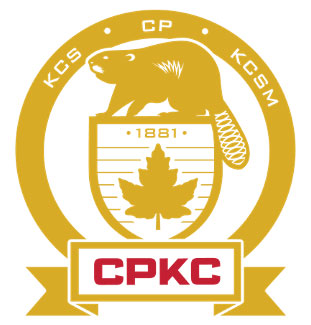|
CP 911001 to 911008 Series Fire Train Bulkhead
Flat
Cars |
 |
|
CPKC Alyth
Yard, Calgary, Alberta,
4/23/2024,
Photo by
Carson Wiebe |
|
In recent years, fire seasons
have been trending more severe, and with a mandate to protect
our right-of-way, CPKC’s hazmat team, mechanical team and
emergency response contractors collaborated to build eight fire
trains using existing freight flats, the most in the industry.
These trains were integral to the team’s success during the 2023
wildfire season, defending CPKC tracks and critical subdivisions
against more than 600 wildfires and earning the team an Operate
Safely CEO Award for Excellence.
Numbered CP 911001 through 911008, each flat is designed by
CPKC’s specialists according to our operational needs. Each flat
is equipped with 230,000 litres of water capacity to dispense at
up to 1,000 gallons per minute. Combined with specialized
training, crews use this equipment to treat vegetation along the
tracks with retardant to prevent and slow a fire, defend against
small active fires, mop up and extinguish smouldering vegetation
and tie fires while aboard a moving train. |
|
CP 911001 |
|
|
CP 911002 |
|
|
CP 911003 |
|
|
CP 911004 |
|
CP Alyth
Yard, Calgary, Alberta |
|
11/23/2022 |
|
Photo by Carson Wiebe |
|
 |
|
|
CP 911005 |
|
CP Alyth
Yard, Calgary, Alberta |
|
11/23/2022 |
|
Photo by Carson Wiebe |
|
 |
|
|
CP 911006 |
|
CP Alyth
Yard, Calgary, Alberta |
|
11/23/2022 |
|
Photo by Carson Wiebe |
|
 |
|
CP 911004 |
|
CP Alyth
Yard, Calgary, Alberta |
|
11/23/2022 |
|
Photo by Carson Wiebe |
|
_11232022s.jpg) |
|
|
CP 911005 |
|
CP Alyth
Yard, Calgary, Alberta |
|
11/23/2022 |
|
Photo by Carson Wiebe |
|
_11232022s.jpg) |
|
|
CP 911006 |
|
CP Alyth
Yard, Calgary, Alberta |
|
11/23/2022 |
|
Photo by Carson Wiebe |
|
_11232022s.jpg) |
|
CP 911004 |
|
CP Alyth
Yard, Calgary, Alberta |
|
11/23/2022 |
|
Photo by Carson Wiebe |
|
.jpg) |
|
|
|
|
|
|
|
CP 911007 |
|
CP Alyth
Yard, Calgary, Alberta |
|
11/23/2022 |
|
Photo by Carson Wiebe |
|
 |
|
|
|
|
CP 911008 |
|
|
CP 911007 |
|
CP Alyth
Yard, Calgary, Alberta |
|
11/23/2022 |
|
Photo by Carson Wiebe |
|
_11232022s.jpg) |
|
|
|
|
|
|
|
|
|
|
|
|
|
|
|
|
1. Each flat is equipped with three or
four water tanks,
totalling
about 7,200 gallons of water. Crews source water from city
hydrants, CPKC yards or city reservoirs.
2. Each flat holds one Tohatsu 400-gallon-per-minute
fire
pump with 2.5-inch discharge to supply the two standpipes with
nozzles.
3. Water lines come in through the bulkheads from tank
cars.
The flats are multi-purpose and crews can source water from the
deck tanks and tank cars, or draft from a nearby river or stream
to save the tank water supply.
4. The railing holds two nozzles on either side that are
connected to the Tohatsu pump. Crews can also hook handlines up
to the railing, allowing them to leave the flat and extinguish
tie fires or small fires along the right-of-way. The hoses and
pumps can be removed and substituted with fire packs that crews
wear on their backs to fight fires from the ground or from
boats.
5. Each fire train has one contracted wildland officer or
CPKC
hazmat officer overseeing the train, and up to five wildland
firefighters.
6. A job box holds extra fittings, hoses and personal
protective equipment.
7. A tote carrying PHOS-CHEK, a fire retardant.
8. A centrifugal water pump runs the two spray bars on
the
bottom of the flat.
9. Each flat has a spray bar on either side of the
bottom.
It sprays
water or PHOS-CHEK on vegetation along the right-of-way to
prevent or control fire.
10.
During the
night, LED deck lights help crews defend CPKC property and the
communities in which we operate. |
|
Text from CPKC Connect Magazine Volume # 3 |






_11232022s.jpg)
_11232022s.jpg)
_11232022s.jpg)
.jpg)

_11232022s.jpg)